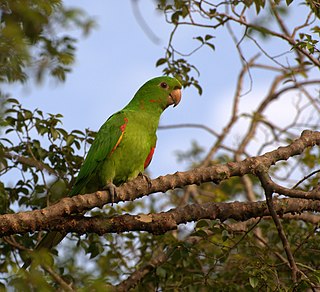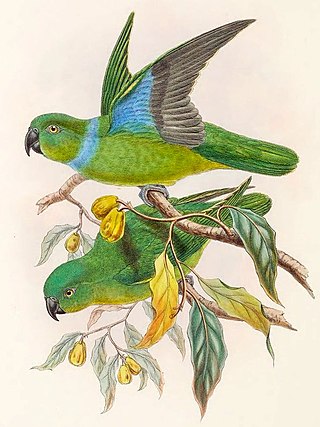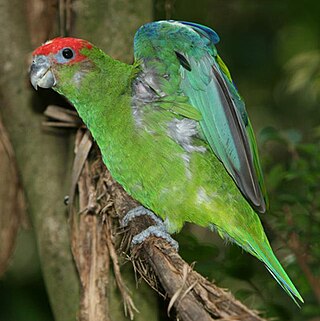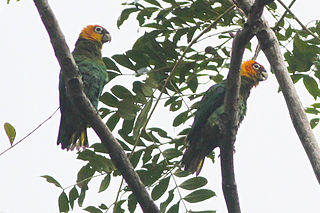
The green-cheeked parakeet, known as the green-cheeked conure in aviculture, is a species of bird in subfamily Arinae of the family Psittacidae, the African and New World parrots. It is found in Argentina, Bolivia, Brazil, and Paraguay.

The neotropical parrots or New World parrots comprise about 150 species in 32 genera found throughout South and Central America, Mexico, the Caribbean islands and the southern United States. Among them are some of the most familiar and iconic parrots, including the blue and gold macaw, sun conure, and yellow-headed amazon.

The brown-hooded parrot is a species of bird in subfamily Arinae of the family Psittacidae, the African and New World parrots. It is found from Mexico to Colombia.

The white-eyed parakeet, known in aviculture as white-eyed conure, is a species of bird in the subfamily Arinae of the family Psittacidae, the African and New World parrots. It is found in every mainland South American country except Chile and also on Trinidad.

The blue-cheeked amazon, also known as blue-cheeked parrot or Dufresne's amazon, is a Near Threatened species of bird in subfamily Arinae of the family Psittacidae, the African and New World parrots. It is found in Brazil, the Guianas, and Venezuela.

The blue-collared parrot also known as simple parrot, lilac-collared song parrot, or lilac-collared Geoffroy's parrot, is a parrot found in the higher elevations of New Guinea. It is found from 500 to 2300 m, mainly between 800 and 1900 m. It is 23–25 cm, mainly green with a black beak, yellow wing bend, blue underwing coverts, and a pale yellow iris. Adult males have a blue collar across upper breast to lower neck above the mantle, adult females have some blue on the rear crown. Juveniles have no blue and a paler bill. There are two subspecies:

The vulturine parrot is a species of bird in subfamily Arinae of the family Psittacidae, the African and New World parrots. It is endemic to Brazil.

The scaly-naped amazon, also known as the scaly-naped parrot, mercenary amazon, Tschudi's amazon, mountain parrot, or gray-naped amazon is a species of parrot in the family Psittacidae. It is found along the Andes in the northern part of South America. Its natural habitats are subtropical or tropical moist lowland forest and subtropical or tropical moist montane forest.

The grey-cheeked parakeet, less commonly known as fire-winged parakeet, is a Vulnerable species of bird in subfamily Arinae of the family Psittacidae, the African and New World parrots. It is found in Ecuador and Peru.

The red-fronted lorikeet, also known as the red-spotted lorikeet or red-rumped lorikeet is a species of parrot in the family Psittaculidae. It is found in northern New Guinea and the island of Biak. Its natural habitat is subtropical or tropical moist montane forests.

The white-bellied parrot, or white-bellied caique in aviculture, is a species of bird in the subfamily Arinae of the family Psittacidae, the African and New World parrots. It is found in Bolivia, Brazil, Colombia, and Peru.

The bald parrot or orange-headed parrot is a species of parrot in the family Psittacidae. It is endemic to the east-central Amazon of Brazil. Its natural habitat is tropical moist lowland forests. It is considered near threatened by BirdLife International due to the widespread deforestation of the Amazon.

The caica parrot is a species of bird in subfamily Arinae of the family Psittacidae, the African and New World parrots. It is found in Brazil, French Guiana, Guyana, Suriname, and Venezuela.

The South American pileated parrot is a species of bird in subfamily Arinae of the family Psittacidae, the African and New World parrots. It is found in Argentina, Brazil, and Paraguay. It was formerly known as the red-capped parrot, easily leading to confusion with the Australian Purpureicephalus spurius that bears that English name.

The rose-faced parrot is a species of bird in subfamily Arinae of the family Psittacidae, the African and New World parrots. It is found in Colombia and Ecuador.

The saffron-headed parrot is a Near Threatened species of bird in subfamily Arinae of the family Psittacidae, the African and New World parrots. It is found in Colombia, Panama, and Venezuela.

The maroon-tailed parakeet is a species of bird in subfamily Arinae of the family Psittacidae, the African and New World parrots. It is found in Brazil, Colombia, Ecuador, Peru, and Venezuela.

The crimson-bellied parakeet, known as the crimson-bellied conure in aviculture, is a species of bird in subfamily Arinae of the family Psittacidae, the African and New World parrots. It is found in Bolivia and Brazil.

The scarlet-shouldered parrotlet, also known as the red-winged parrotlet or Huet's parrotlet, is a species of bird in subfamily Arinae of the family Psittacidae, the African and New World parrots. It is found in Bolivia, Brazil, Colombia, Ecuador, Guyana, Peru, and Venezuela, possibly in Suriname, and as a vagrant to Trinidad and Tobago.

The golden-tailed parrotlet is a Vulnerable species of bird in subfamily Arinae of the family Psittacidae, the African and New World parrots. It is endemic to eastern Brazil.






















